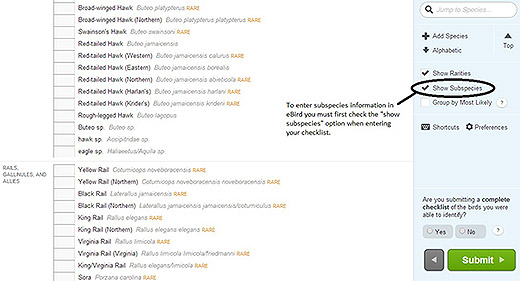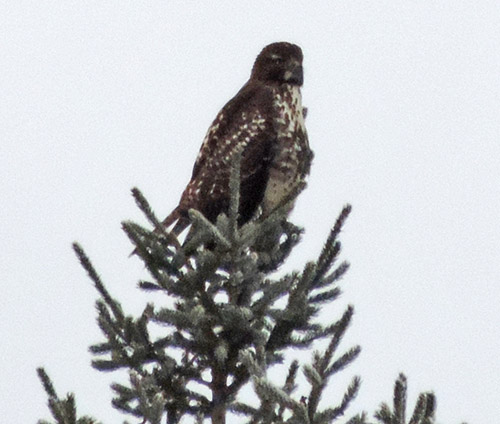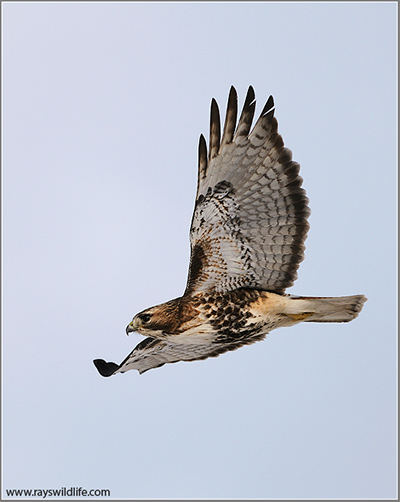Identifying Northern Red-tailed Hawks

Canada is a huge country and the geographic variation exhibited by our birds can be substantial. Perhaps no species displays a greater variability across the continent than the familiar Red-tailed Hawk. Sorting through the various subspecies of this well-known raptor can be a challenge for birders of all skill levels.
eBird is a great place to report your specific sightings of Red-tailed Hawks but, if you go one step further and identify and report it to the subspecies level, you are adding valuable information to our understanding of subspecies ranges and patterns of frequency and abundance. Submitting observations to the subspecies level is simple; you just have to check the “show subspecies” option in the right-hand margin of the species list step when you are submitting your checklist (Figure 1). You might also have to check “show rarities” if the subspecies is listed as rare for that date or location. In some cases a subspecies might not appear in checklist. If that is the case, click the “add species” button in the margin and start typing its name until the option pops up. Subspecies aren’t always straightforward so be sure to include comments, particularly for out of range subspecies, in the species comments about how you identified it as that subspecies.
Figure 1: You’ll need to check the “show subspecies” option to be able to enter data to subspecies level in eBird
To get an idea of the range for each of the reportable Red-tailed Hawk subspecies in Canada check out the links below to their eBird maps:
Red-tailed Hawk (Western) (Buteo jamaicensis calurus)
Red-tailed Hawk (Eastern) (Buteo jamaicensis borealis)
Red-tailed Hawk (Harlan’s) (Buteo jamaicensis harlani)
Red-tailed Hawk (Krider’s) (Buteo jamaicensis kriderii)
Red-tailed Hawk (Northern) (Buteo jamaicensis abieticola)
Of the above subspecies, the least known (and least eBirded) seems to be the Northern Red-tailed Hawk. Jon Ruddy of Ottawa has put together this excellent summary which will hopefully encourage eBirders in eastern Canada to start watching for and reporting their observation of this beautiful bird!
Northern Red-tailed Hawk (Buteo jamaicensis abieticola)
by Jon Ruddy
A hawk, once determined to be a Red-tailed, is usually ignored thereafter. I felt the same until I laid my eyes upon my first Northern Red-tailed Hawk (abieticola). My introduction to abieticola could not have been more of an epiphany. On 21 November 2013, Michael Runtz and I were birding in Prince Edward County, Ontario. We encountered a very heavily-marked adult Red-tailed Hawk exhibiting a dark hood and a complete dark brown belly band which increased in girth towards its flanks. This bird, if seen ventrally, and at a great distance, could easily have passed as a Rough-legged Hawk. It was a phenomenal sight and left a lasting impact.
Northern Red-tailed Hawks were first described by Todd (1950); he noted a population of Red-tailed Hawks distinct from other Red-taileds in the east by their rich coloration and heavy streaking. Todd described this population breeding in the boreal forest of Quebec and Labrador east of Hudson Bay. Dickerman and Parkes (1987) described the range of abieticola as existing throughout the spruce/fir belt from Alberta east to the Maritime Provinces. Classic individuals of abieticola are quite distinct from borealis, and more similar in appearance to typical examples of calurus. In calurus, typical light morph adults show bold, rufous-tinted, extensive markings to the underside, multiple tail bands, a dark, faintly mottled upperwing, and dark throat (Liguroi 2001). Typical examples of abieticola show a noticeably dark head in which streaks “dribble” out from the sides of the throat and onto the upper breast, deep brown back (on average, noticeably darker than typical borealis), and extensive belly band composed of globular streaks which, in some individuals, forms a solid band which is “pinched in” at the center, and grows in width towards the flanks. The base color, especially throughout the upper breast, is more buffy/orange-toned in coloration than what is seen with typical borealis Red-taileds. The tails of adult abieticola are quite similar to borealis though Todd (1950) described the subterminal band as being thicker. This was not found to be a reliable field mark when Dickerman and Parkes (1987) investigated abieticola; they found extensive overlap in subterminal width when comparing adult borealis and abieticola specimens. Dickerman (1989) stated that adult abieticola from the western population can show ancillary barring along the tail, though it is important to note that the extent of ancillary barring and thickness of the subterminal band vary within and among subspecies populations (Liguori 2001). I was able to observe an adult specimen on 1 December 2013 which showed ancillary barring along the tail and a thick, black subterminal band.
It is cautioned by North American raptor experts, Jerry Liguori and Brian Sullivan, that there is great overlap in plumage of juvenile Red-tailed Hawks among several subspecies and many specimens’ subspecific origins are better left safely undetermined. A classic juvenile abieticola is similar to a juvenile borealis but more heavily-marked, showing a dark brown head, a marked throat (though, sometimes, unmarked) which is demarcated by heavy malar streaks, “dribbling” of dark brown from the nape area into the upper breast and more extensive bellyband. Sometimes, this band is thinnest at its center and increases in girth towards the flanks.
Migrating Northern Red-tailed Hawks (abieticola) can be observed at eastern hawkwatch sites such as Niagara Peninsula Hawkwatch, Braddock Bay, and Derby Hill; the latter two hawkwatch sites are located along the southern (Braddock Bay) and eastern (Derby Hill) shore of Lake Ontario. Northern Red-taileds can be seen migrating northward to their boreal haunts beginning in March. Most adult Red-taileds migrating by the Niagara Peninsula Hawkwatch near Grimsby in April are abieticola. In October and November, many of the Red-taileds passing High Park Raptor Watch in Toronto are also the more heavily pigmented northern birds. During winter, Northern Red-taileds, like other birds of prey, can be found where there is a concentration of food available. In early December throughout the west end of Ottawa, Ontario, most of the Red-taileds I saw fit the profile of abieticola; many winter in southern Ontario (Pittaway 1998).
Figure 2: A wonderfully dark and heavily-marked juvenile Northern Red-tailed Hawk (abieticola). Note the deep brown throughout its head area, which lacks contrast with its back. See also its well-marked throat and “dribbles” of deep brown that extend from the throat and nape onto the upper breast. Its extensive belly band is also visible from this angle.
Ottawa, Ontario. 5 December 2013
Figure 3: A lovely textbook adult Northern Red-tailed Hawk (abieticola) showing a dark head, rufous upperparts, “dribbles” extending from the head onto the sides of the breast, and an extensive, blackish belly band composed of globular streaks.
Hamilton Mountain, Ontario. 21 February 2008
Figure 4: Adult Northern Red-tailed Hawk (abieticola). Note the extensive dark belly band, buffier base color to the front-parts, and, well-marked throat that dribbles onto a very buffy breast. The low angle sunlight really accentuates its rufous coloration. From a distance, this Northern Red-tailed could possibly pass as a Rough-legged given the width and vividness of its belly band.
Ottawa, Ontario. 3 February 2014
Figure 5: Dorsal view of an adult Northern Red-tailed Hawk (abieticola). Note the deep brown wash with reduced paleness throughout its upperside.
Hamilton, Ontario. 24 January 2009
Figure 6: An adult Northern Red-tailed Hawk (abieticola) showing some of the features that make abieticola Red-tailed Hawks so captivating. Note the rich coloration throughout its head with “dribbles” of dark brown/rufous extending down onto the sides of the breast. The extensive, globular-marked, dark belly finishes off this textbook specimen. This particular belly band is at the “heavily-marked” end of the Northern Red-tailed spectrum.
Hamilton Mountain, Ontario. 23 February 2008
Contributed by Jon Ruddy, Ottawa, Ontario
Acknowledgements
I thank Michael Runtz for encouraging my interest in Red-tailed Hawks. Thank you to Michel Gosselin of the Canadian Museum of Nature for allowing me to investigate study skins in the bird collection. Thank you to Ron Pittaway for sharing his knowledge of and enthusiasm for abieticola Red-taileds; Ron assisted me in my first identification of an abieticola Red-tailed. I’m indebted to Raymond Barlow for allowing me to use his photographs to help illustrate abieticola features. Jerry Liguori, Brian Sullivan, Ron Pittaway, Jean Iron, and Mike Burrell provided many valuable comments on an earlier version of this manuscript.
References
Carrolan, T. 2010. Redtails R Us. http://www.hawksaloft.com/RedtailsRus.html
Dickerman, R. 1989. Identification of Red-tailed Hawks wintering in Kansas, Kansas Ornithological Society. http://www.ksbirds.org/kos/bulletin/Vol40No4.pdf
Dickerman R. and K. Parkes. 1987. Subspecies of the Red-tailed Hawk in the Northeast in The Kingbird 37(2): 57-64. New York State Ornithological Association.http://nybirds.org/KB_IssuesArchive/y1987v37n2.pdf
Dunne, P., D. Sibley, and C. Sutton. 1988. Hawks in Flight Houghton Mifflin (Boston)
Iron, J. Dark morph Red-tailed Hawk: calurus or abieticola? TOC Newsletter, February 2012, Toronto Ornithological Club. http://www.jeaniron.ca/2012/darkredtailsTOCNews.pdf
Liguori, J., and B. Sullivan. 2010. Comparison of Harlan’s with Western and Eastern Red-tailed Hawks. Birding 42(2)2:30-37. http://www.aba.org/birding/v42n2p30.pdf
Liguori, J. 2001. Pitfalls of Classifying Light Morph Red-tailed Hawks to Subspecies. Birding 33(5): 436-446.
Liguori, J. 2004. Dark Red-tailed Hawks. Birding 36(3): 278-83. http://www.aba.org/birding/v36n5p500.pdf
Liguori, J. 2005. Hawks from Every Angle. Princeton University Press (Princeton, N.J.).
Pittaway, R. 1993. Subspecies and Morphs of the Red-tailed Hawk in Ontario Birds 11(1): 23-29. Ontario Field Ornithologists. http://www.jeaniron.ca/2010/redtailsRF.pdf
Pittaway, R. 1998. Northern Redtails. OFO News 16(1):4. http://www.jeaniron.ca/2014/northernredtails.htm
Pittaway, R. 1999. Fall Hawkwatching Guide. OFO News 17(3):1–8. http://www.ofo.ca/site/page/view/articles.hawkwatching
Ruddy, J. 2014. Northern Red-tailed Hawk: Identification, Natural History, and Winter Survey. http://jonruddy.blogspot.ca/2014/02/northern-red-tailed-hawk-identification.html






